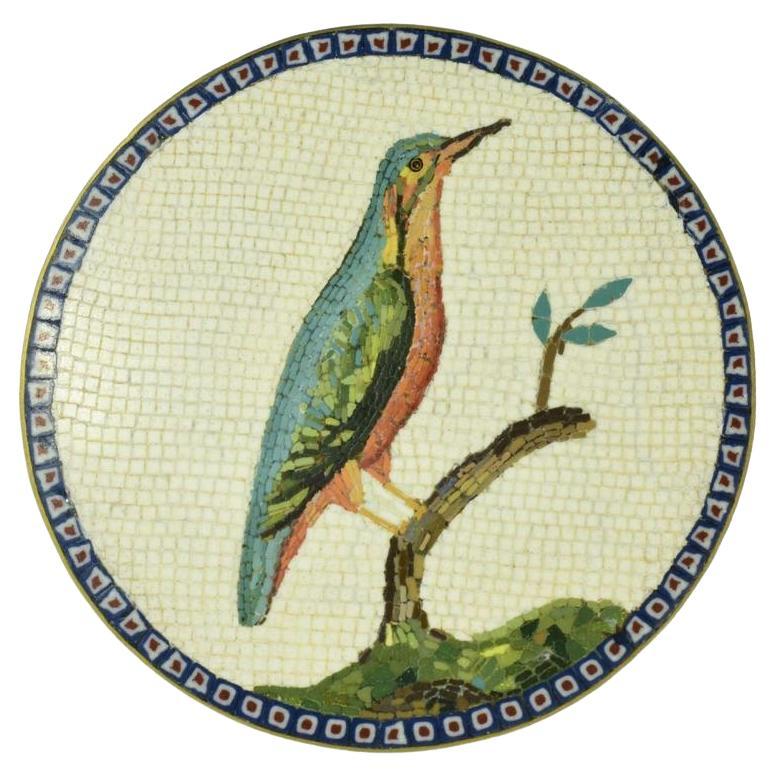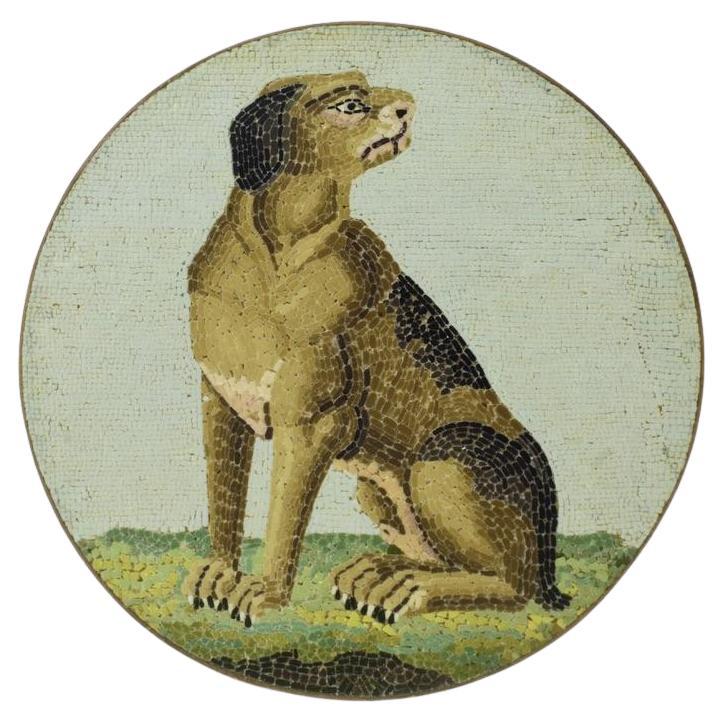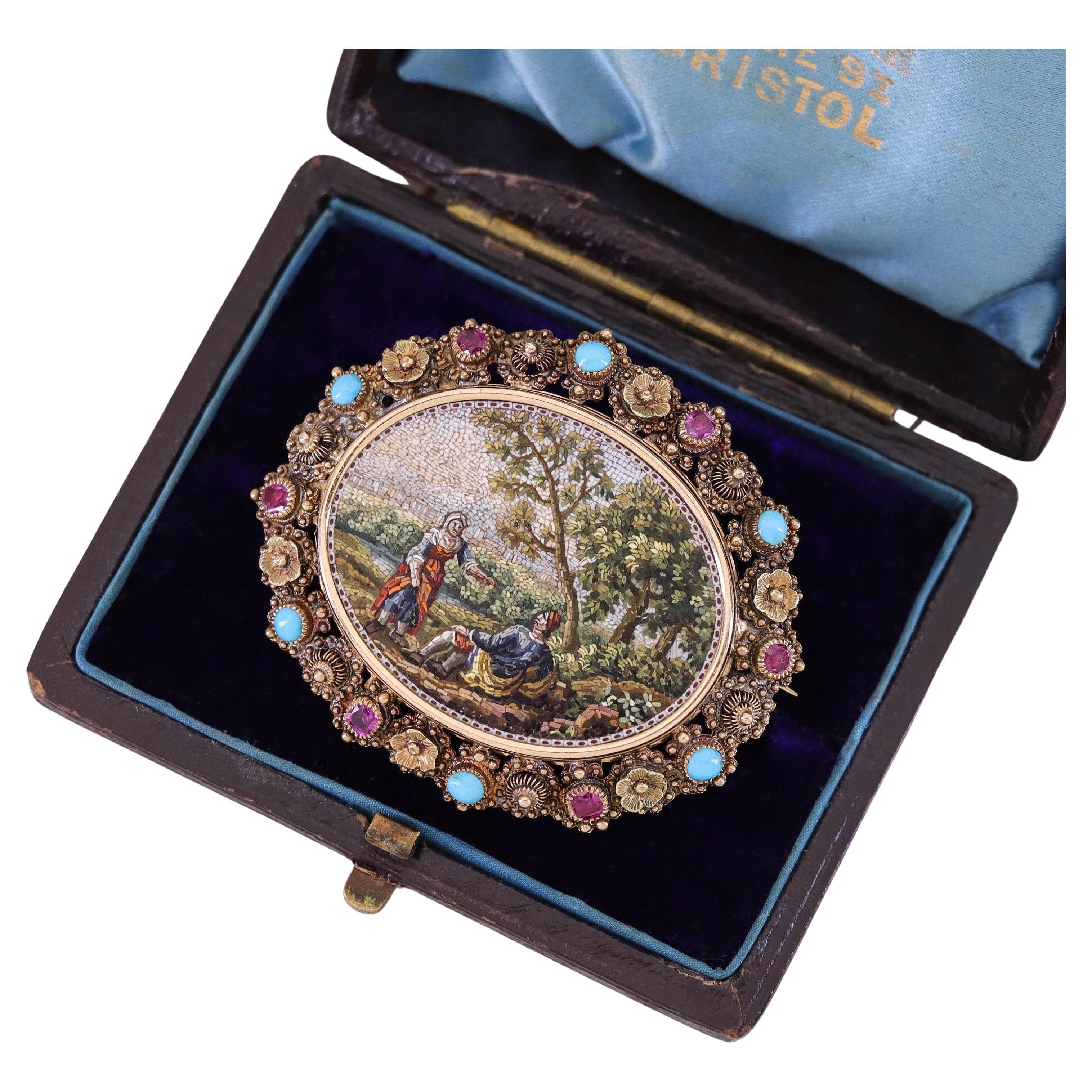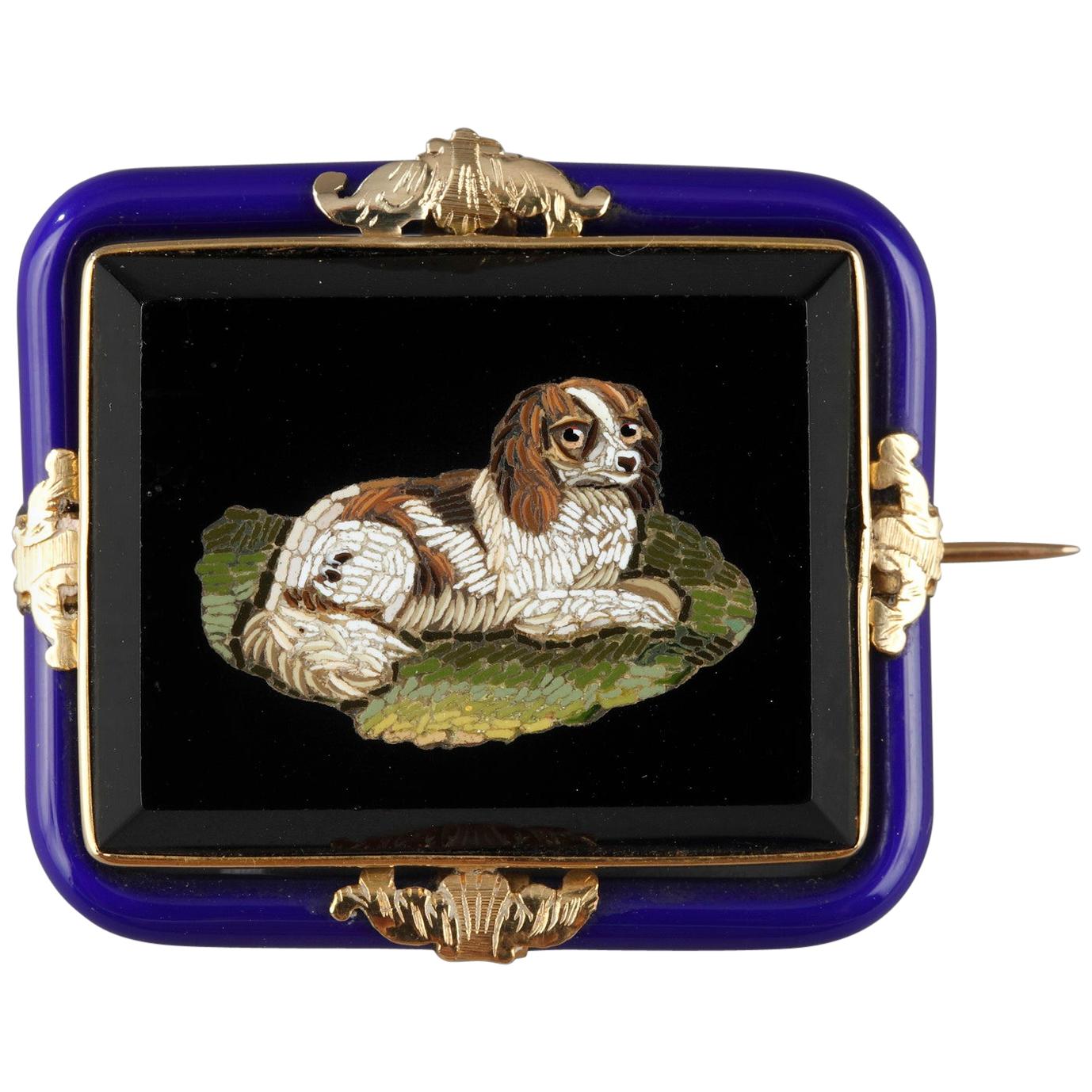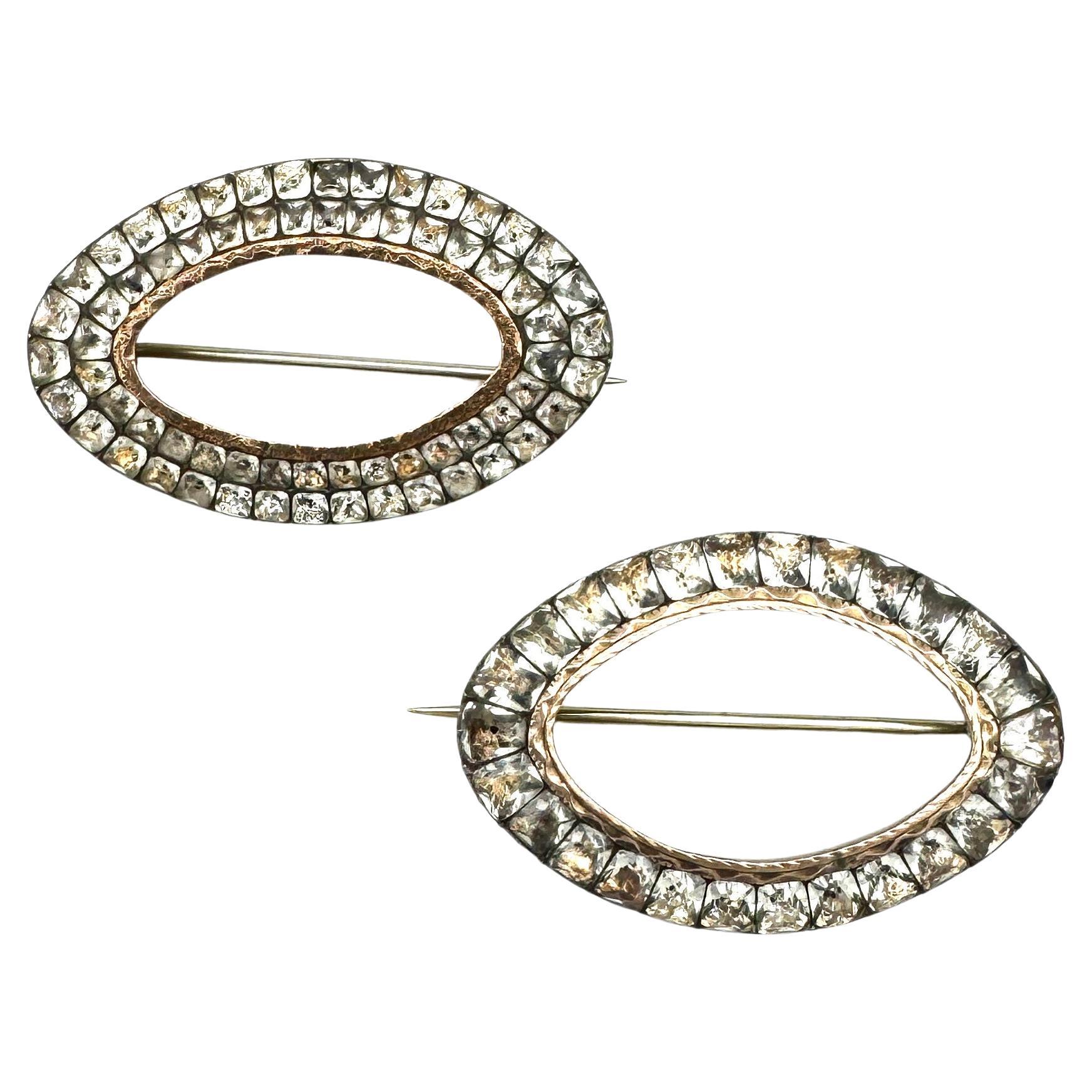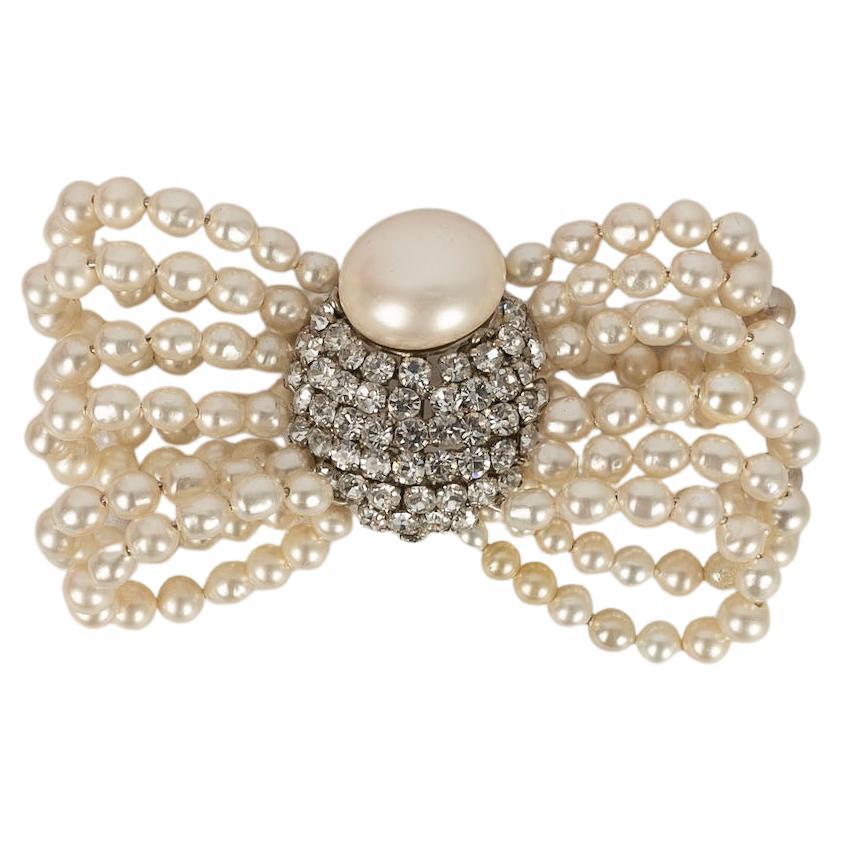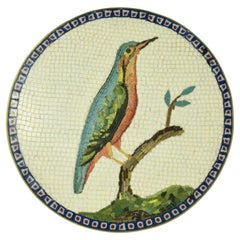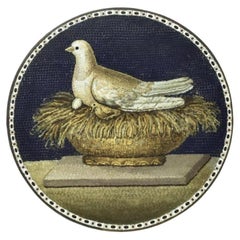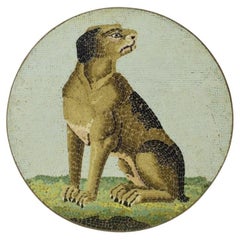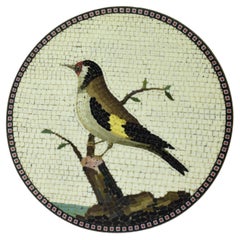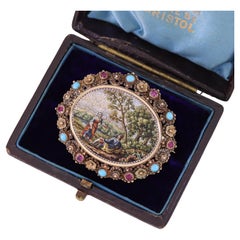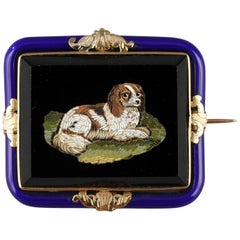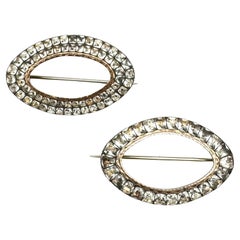Items Similar to 18th Century Micromosaic of a Goldfinch, c. 1790, attributed to G. Raffaelli
Want more images or videos?
Request additional images or videos from the seller
1 of 10
18th Century Micromosaic of a Goldfinch, c. 1790, attributed to G. Raffaelli
About the Item
18th Century micromosaic plaque of a Goldfinch, Rome, c. 1785, attributed to Giacomo Raffaelli (1753-1836). A micromosaic plaque of a goldfinch, looking left, perched on a red flowering tree branch, two inches in diameter. The ground line is parallel and low. The foreground is of different colors of grass and fallen berries and leaves. The background is a light blue with parallel lines of square tesserae. The goldfinch has both square and oblong tesserae as does the foreground. The border of a decorative pattern in white in black circles and further with a rim of yellow oblong tesserae create a colorful frame for this well executed micromosaic which is backed with copper.
There is a pinstem and "c" clasp (this type of clasp is seen both in the 18th and 19th centuries), both are not gold. This assembly could have been put on at the time of purchase or slightly later so the plaque could be worn as a brooch.
We have dated this piece as being at the end of the 18th century and attributed to Giacomo Raffaelli. This micromosaic has all of the established 18th century characteristics of micromosaics executed by Giacomo Raffaelli: 1. Each tesserae possesses one color. 2. The tesserae are either oblong or square. 3. The background is parallel horizontal rows of square tesserae, and 4. The addition of an identical border or millefiori around the edge. See page 32 of "The Gilbert Collection Micromosaics by Jeanette H. Gabriel. Philip Wilson Publishers.
Giacomo Raffaelli (1753-1836) is one the most important artists of micromosaics, his signed pieces are almost nowhere to be found - unless in museums and important collections of the world. We know of nine that exist in the world. Two in the Hermitage, two in the renowned Gilbert Collection, one in the British Museum, three held by different companies in the trade, and one held by Pierre/Famille ( for sale on this platform). Raffaelli was considered the finest mosaicist in Rome. Indeed, when Napoleon I wanted to sponsor a mosaic version of The Last Supper, in roughly 1810, he chose Raffaelli, this too added much to his fame.
A very similar plaque, also attributed to Raffaelli, can be seen in the above referenced book on page 56. This plaque is part of The Gilbert Collection. The permanent collection is on view at the Victoria & Albert Museum in London.
Raffaelli is known for his very realistic depictions of birds - especially the Goldfinch. While his naturalism is among the finest of mosaicists at this time, Raffaelli chose to display his extraordinary talent featuring the goldfinch in many of his works.
Raffaelli was probably aware of the significance of the goldfinch to the Catholic Church. Afterall, it is one of the most poignant stories in the Passion of Christ. On the road to Golgotha, Christ was forced to carry the cross upon which he would be crucified. He was also made to wear a brutal crown of thorns. It was said that a simple Goldfinch, having alighted on the Savior's shoulder, flew to his head and plucked a thorn that had been making Christ bleed; whereupon this blood was transferred to the finch, which to this day, still wears it. This is but one example as to how mosaics permitted the Church to teach important lessons or parables. Why was this not done by traditional art forms such as paintings? Why was this done instead by mosaics?
From its initial conception at approximately 319 AD, the Church sought to locate St. Peter's Basilica at the site of the apostle's martyrdom. On its face such a decision would seem rational, if not appropriate.
St. Peter however was executed in a marshy area on a side of the Tiber in the already quite humid city of Rome. Housed in the early St. Peters with its exposure for so many centuries of very high humidity most of the Basilica's artwork was beyond the help of the rudimentary preservation and restoration of the period. By about 1750 to which the "new" St. Peters dates it had therefore lost many oil and watercolor paintings as well as wood, bone, and tortoise sculptures, frames and other artifacts.
What could the Church do? Enter the "new" age of Roman micromosaics in which tiny pieces of colored stone or glass when set with grout would prove to be impervious to the debilitating effects of humidity.
By the early 1700's the Church would begin the process of establishing a school of instruction in mosaics. It would sponsor research and experimentation in developing especially glass tesserae and would encourage students to select damaged oils, paintings or watercolors as appropriate subjects for duplicative efforts in micromosaics.
Gifted instructors and successful students both frequently had their work promulgated by the Church. And it was from this pool of recently praised practitioners that fame, and special commissions paralleled each other.
By about 1780 one mosaicist in particular separated himself from most all the others. Giacomo Raffaelli became one of the most feted mosaicists in all of Rome. Indeed when Napoleon I wanted to sponsor a mosaic version of the Last Supper in roughly 1810 he chose Raffaelli. This selection itself added to the already high reputation of Raffaelli.
This micromosaic is in very good condition and probably executed by one of the greatest of mosaicists of all time, and done on a work of art symbolically significant to the early Catholic Church.
We have one of the largest collections of micromosaics offered for sale. If our reader is searching for a particular motif, we would be happy to list it here for your consideration. From very large wall hangings, to desk objects such as paperweights to the smallest of brooches, one needs only to ask.
All items sold are accompanied by a detailed Statement of Value. As always, we guarantee all of pieces to be exactly as represented.
Over the decades of our stewardship as a small but exemplary purveyor of the jeweler's art, we have strived to offer a fine and authentic selection, in excellent condition, of collectible jewels from all highly sought time periods at competitive prices and even lower prices, if possible. In the process we have had the extraordinary good fortune of meeting remarkable people - some collectors, others just extremely interesting individuals who have taken the time and effort to examine their lives and select things that tend to make them smile, or admire, or just wonder at the exciting, endlessly creative and nuanced panoply of jeweled artifacts.
- Style:Georgian
- Place of Origin:Italy
- Period:1790-1799
- Date of Manufacture:1790
- Condition:
- Seller Location:Aspen, CO
- Reference Number:Seller: 11028441stDibs: LU19223580162
About the Seller
5.0
Recognized Seller
These prestigious sellers are industry leaders and represent the highest echelon for item quality and design.
Gold Seller
Premium sellers maintaining a 4.3+ rating and 24-hour response times
Established in 1979
1stDibs seller since 2011
665 sales on 1stDibs
Typical response time: 5 hours
- ShippingRetrieving quote...Shipping from: Aspen, CO
- Return Policy
Authenticity Guarantee
In the unlikely event there’s an issue with an item’s authenticity, contact us within 1 year for a full refund. DetailsMoney-Back Guarantee
If your item is not as described, is damaged in transit, or does not arrive, contact us within 7 days for a full refund. Details24-Hour Cancellation
You have a 24-hour grace period in which to reconsider your purchase, with no questions asked.Vetted Professional Sellers
Our world-class sellers must adhere to strict standards for service and quality, maintaining the integrity of our listings.Price-Match Guarantee
If you find that a seller listed the same item for a lower price elsewhere, we’ll match it.Trusted Global Delivery
Our best-in-class carrier network provides specialized shipping options worldwide, including custom delivery.More From This Seller
View All18th Century Micromosaic Plaque of a Bluebird, attributed to G. Raffaelli.
Located in Aspen, CO
18th Century micromosaic plaque of a bluebird, Rome, c. 1785, attributed to Giacomo Raffaelli (1753-1836). A micromosaic plaque of a blue bird perched on a flowering tree branch, 2.2...
Category
Antique 1780s Italian Georgian Brooches
$10,400 Sale Price
20% Off
Free Shipping
18th Century Micromosaic, Rome, c. 1795, Attributed to G. Raffaelli
Located in Aspen, CO
18th century micromosaic of a turtle dove on her nest with a chick, attributed to Giacomo Raffaelli.
To see a similar plaque, signed and dated Giacomo Raffaelli, 1791; see: Aste Bol...
Category
Antique 1790s Italian Georgian Desk Accessories
$11,120 Sale Price
20% Off
Free Shipping
18th Century Micromosaic Plaque, possibly by G. Raffaelli, c. 1780
Located in Aspen, CO
18th century micromosaic plaque of a dog looking right. The sparse but interesting vegetation in the foreground, the light blue background set with horizontal oblong or square tesse...
Category
Antique 1780s Italian Georgian Brooches
$11,200 Sale Price
20% Off
Free Shipping
Micromosaic Plaque of the Goldfinch, signed and dated by Giacomo Raffaelli, 1784
Located in Aspen, CO
Micromosaic plaque of the Goldfinch This circular plaque is 3 inches in diameter, the micromosaic is set in copper. On the verso, the piece is signed...
Category
Antique 1780s Italian Georgian Desk Accessories
$24,000 Sale Price
20% Off
Free Shipping
Antique Micromosaic 18K Gold Brooch, French, c. 1880
Located in Aspen, CO
Antique micromosaic 18K gold brooch bearing French hallmarks. The brooch was made in France and the micromosaic is probably Italian. The motif is unusual of a watermelon seller. T...
Category
Antique 1880s Victorian Brooches
Materials
18k Gold
$2,760 Sale Price
20% Off
Micromosaic Plaque of a Landscape Scene, Rome, circa 1800.
Located in Aspen, CO
Antique micromosaic of an Italian landscape scene with two sentries in the foreground standing watch by the water with a town on the right, and a curving tree on the left and mountai...
Category
Antique Early 1800s Georgian Brooches
You May Also Like
Antique Micromosaic Brooch of 18k Gold
Located in Lewisburg, PA
An exceptional micromosaic brooch (circa 1800-1825) reminiscent of a fine renaissance era painting.
Created by the hands of a master craftsman, this extraordinary miniature work of ...
Category
Antique Early 19th Century Renaissance Brooches
Materials
Ruby, Turquoise, 18k Gold
Mid-19th Century Gold Brooch with Micromosaic
Located in Paris, FR
Brooch with a micromosaic set in a gold and royal blue enameled gold setting. Rectangular micromosaic on black onyx representing a spaniel lying in the...
Category
Antique 1830s French Brooches
Materials
Gold
Antique 18th Century Pair Of Paste and Metal Brooches
Located in Munich, Bavaria
These elegant brooches were handcrafted in the second half of the eighteenth century.
The brooch to the top left is made out of two pointed ovals of beautifully cut slightly trapeze ...
Category
Antique 1770s European George II Brooches
Materials
Silver
Dior brooch (attributed to)
By Christian Dior
Located in SAINT-OUEN-SUR-SEINE, FR
DIOR -(Attributed to) Silver plated metal brooch, pearly pearls and strass. Not signed.
Condition:
Very good condition
Dimensions:
9 cm x 5.5 cm
SKU:BR143
Category
Vintage 1980s French Brooches
Torrente brooch (Attributed to)
Located in SAINT-OUEN-SUR-SEINE, FR
TORRENTE - Brooch in gilded metal symbolizing a leaf. Unsigned, it is attributed to Torrente.
Condition:
Very good condition
Dimensions:
Length : 5,5 cm
SKU:BR6
Category
1990s French Brooches
Rare 18th Century Painted Enamel Gold Brooch
Located in Chicago, IL
An 18th century enamel on gold brooch embellished with pearls, circa 1790. The enamel miniature on the front shows a boy flying a kite against a sunny Mediterranean landscape. The b...
Category
Antique 18th Century Georgian Brooches
Materials
Pearl, Gold, Enamel
Recently Viewed
View AllMore Ways To Browse
18th Century Gold
Crown Of Light Jewlery
Circle Of G
High School Jewelry
Antique Jewelry Museum
19th Century Italian Jewelry
G Albert
Christ Jewelry
Roman Glass Jewelry
18th Century Gold Crosses
Catholic Jewelry
Georgian Copper
Shoulder Brooch
S Initial Jewelry
Georgia 2 Stone
Georgian 2 Stone
Antique End Of Day Glass
Jewellery 1790
